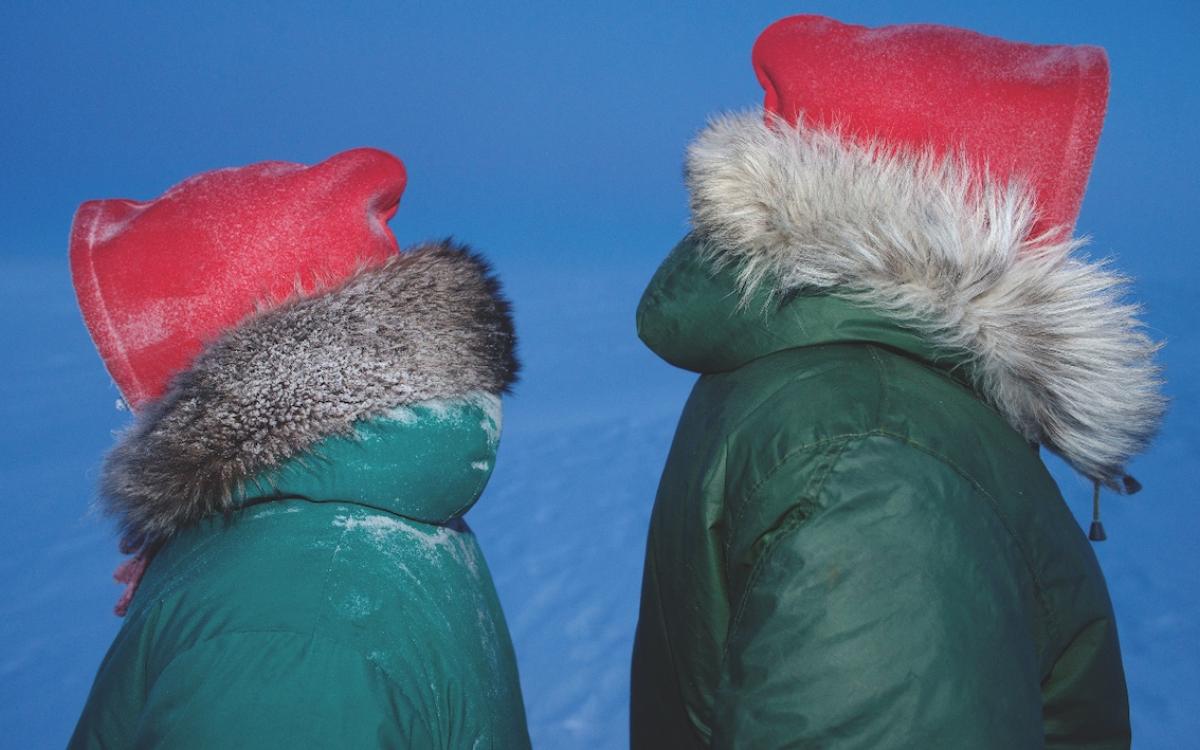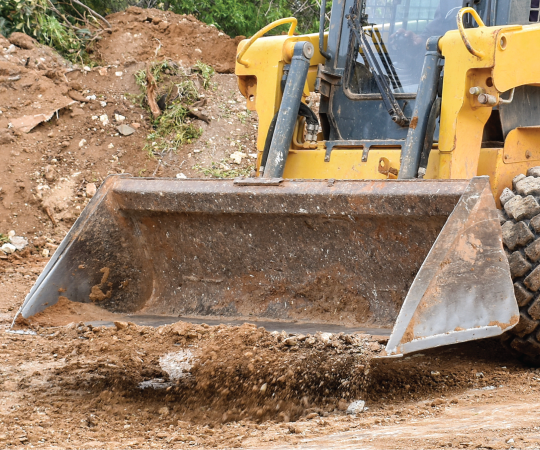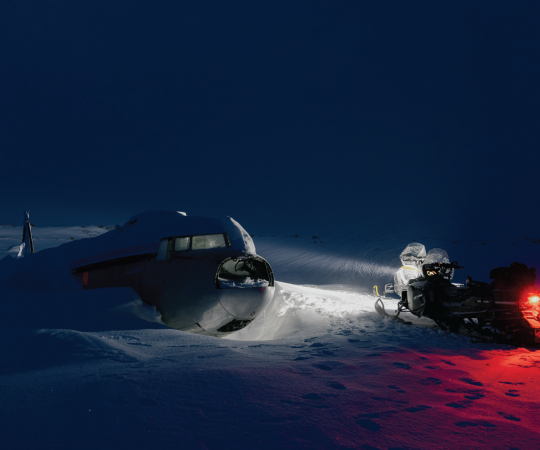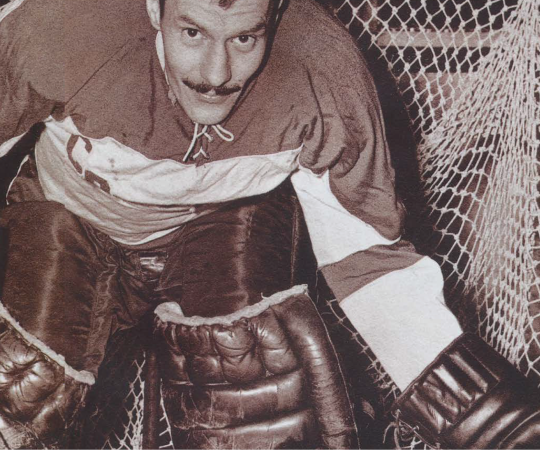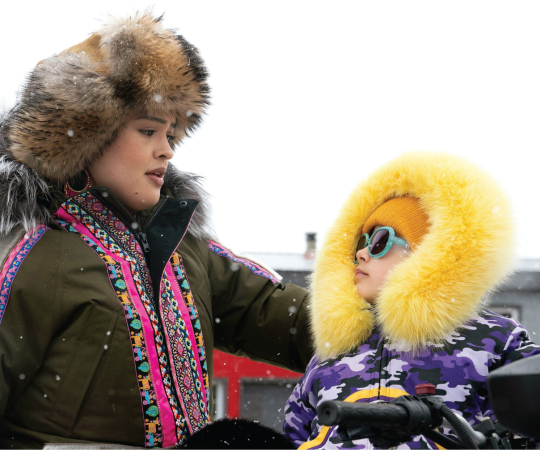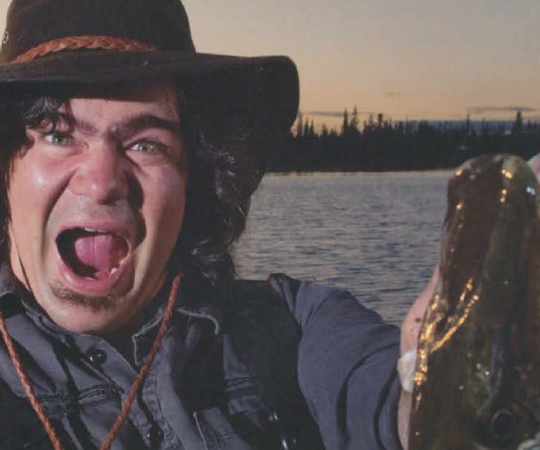Plucked straight from a science-fiction plot, a man haloed in light stands in front of a glowing sphere on the ice while everything around him is black. “It’s actually the most normal thing,” says photographer Louie Palu. The light around the man comes from a snowmachine and the glow on the ground is from his headlamp. He’s pulling a fishnet during a Canadian Ranger patrol of King William Island.
At the McMichael Gallery in Kleinberg, Ontario, Palu reminisces about the series of photographs in his new exhibition, Distant Early Warning. He was returning to Gjoa Haven from a five-hour snowmachine trip when he came across the man on the ice. “It was a brutal trip, one half of my goggles were iced over, I was pissed off,” he says. “But then I came across this scene.”
From 2015 to 2018—and with funding from the John Simon Guggenheim Memorial Foundation, National Geographic Society and Pulitzer Center—the award-winning conflict zone photojournalist captured what many have dubbed the militarization of the Arctic, and what Palu calls preparing for the unknown.
The photos in the exhibit follow the Armed Forces to Yellowknife for through-the-ice training on frozen Jackfish Lake; to the shore of Blue Fox Harbour where a Canadian soldier toggled with a radio awaiting pick-up after a reconnaissance exercise; to Alaska, where 400 parachutes rained down in a mock invasion. Palu stood in the landing area waiting for the perfect shot. It took a week. He spent time in communities from Nunavut to Alaska, at peoples’ homes and camps, with frigid hands and frozen batteries.
“What I’ve tried to show, having covered wars many times, is there are all these subtle layers of how militaries operate and prepare for things,” says Palu. “It’s more than two armies lining up and firing at each other.”
Palu grew up during the Cold War, when the emergency broadcast system messages flashed on his television screen to test warnings for an imminent attack. Decades later he was in Afghanistan, sent by the Globe and Mail to shoot the drug war at the U.S.-Mexico border. “After covering what we conventionally think is conflict in the age of terrorism and Al Qaeda and 9/11, things happen like the flag planting under the North Pole and conflict in Ukraine,” says Palu. “There were a lot of conversations going on that I remember from the Cold War.”

In 2007, the same year that Russia drove its flag into the seabed at the North Pole, the lowest sea ice extent in history was recorded: new battlegrounds opened and one Arctic superpower made an aggressive move. These were tangible concepts, illustratable even, which isn’t always the case in both climate change and geopolitics. “It got people imagining a future, just like they imagined missiles or bombers coming over the North Pole in the ’50s,” says Palu.
Currently, Russia’s claim to an extended continental shelf—and the mineral, oil, and gas within it—has passed one step of the United Nations’ assessment process, proving the geological similarities between their territory and the continental shelf beyond it. Canada just entered its own claim that overlaps with those of Russia and Denmark. ˚
“Just in the last few weeks as we were getting the exhibition set up, there’s this conflict back to the ’80s over the Northwest Passage,” says Palu. In May, U.S. Secretary of State Mike Pompeo called Canada’s claim to the Arctic waterway “illegitimate”—another sign that the territorial war over the Arctic is far from settled. “I always defer back to the Inuit. They’re the first people on that land. It is their land and the waters are theirs. They should be the lead voice in all these discussions.” This is not no man’s land.
The potential for a second Cold War got Palu wondering about the Arctic, changes in the environment and the North Warning System, the belt of radar stations that replaced the Distant Early Warning Line and provide surveillance and early detection of attacks entering North American air space.
Signals are a broad theme throughout the exhibit, from ground-signals and flares, to the bright red hoods of the Canadian Rangers who are the most consistent on-the-ground presence of Arctic defence.
In one of the exhibit’s photographs, two soldiers in balaclavas stand within a partially constructed iglu as snow falls around them. Inuit knowledge and practice —targeted for erasure by the residential school system—is critical to survival here.
“There are very few places as defined, and whose identity is as described by peoples’ imaginations as the Arctic,” says Palu. “That’s kind of my job, to go somewhere and help you imagine what I’ve seen. To bring back pictures that show something you couldn’t imagine or challenges what you were imagining.”
Another photograph captures a massive military resupply plane unloading qamutiiq in Hall Beach. It’s telling, Palu says, that there is a need for both million-dollar aircraft and traditional transportation methods. Inuit trainers, as well as Rangers, are a big component of Arctic defence, emergency preparedness and search and rescue. And military search and rescue is increasingly important as more activity takes place in the Arctic and more people come into this space.
“The thing I love about covering the military is they’re so practical,” Palu says. “You can tell a lot about what’s going on by the equipment and clothing they order: ‘We need this kind of aircraft, this kind of snowmobile, this kind of gun.’ You can tell right away what they’re preparing for.”
In Canada, a new fleet of Arctic patrol ships is in the works and the government just upped the order from six to eight in May. A military resupply station is set to open, eventually, at Nanisivik Naval Facility. Ottawa just purchased thousands of new rifles for the Canadian Rangers.
“I think they’re preparing for the big unknown and the big unknown is everything,” says Palu. “In the Arctic, I think everybody is in agreement things are changing. Why it’s changing, there are debates at higher and lower levels, but everybody knows there’s a very big change coming.”
One of Palu’s trips for his series was on the Mackenzie River with the navy, from Yellowknife to Tuktoyaktuk and back. It took about 10 days and along the way they sussed out the erosion, the amount of debris in the water and the way it affected the motors, setting the trip back. “We saw just how powerful nature is, even when you’re degrading it. It pushes back and I think what we’re preparing for is what the big pushback is going to be,” he says. “We don’t know what it’s going to be and whether it will lead to one of those unknowns in the future that might require security.”
Distant Early Warning runs now to September 22 as part of the Scotiabank CONTACT Photography Festival.

